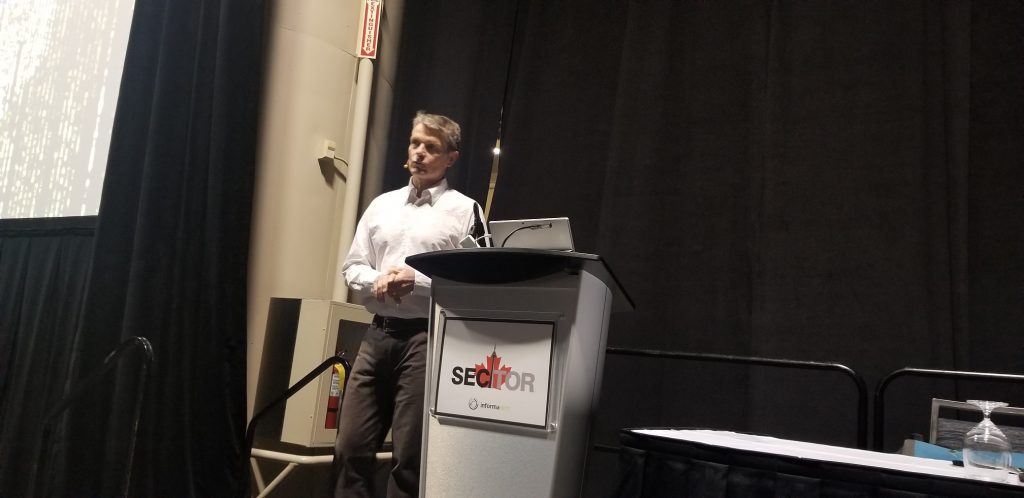It was a rapid, but for a packed home of delegates attending a SecTor 2022 session in Toronto, an eye-opening 20-minute tutorial that explored the litany of Russian cyberattacks in Ukraine and what has been done to protect against them given that the war broke out on Feb. 23.
The presentation on Wednesday from John Hewie, nationwide safety officer with Microsoft Canada, centred on a report issued in late June entitled Defending Ukraine: Early Lessons from the Cyber War, that was included in IT Globe Canada the working day it was released.
In a foreword to it, Brad Smith, president and vice chair at Microsoft, wrote that the invasion “relies in part on a cyber tactic that consists of at least three unique and occasionally coordinated initiatives – destructive cyberattacks inside Ukraine, network penetration and espionage outside Ukraine, and cyber impact functioning focusing on folks close to the entire world.
“When nations send out code into fight, their weapons move at the pace of gentle. The internet’s world pathways suggest that cyber activities erase significantly of the longstanding security presented by borders, partitions and oceans. And the web alone, contrary to land, sea and the air, is a human generation that relies on a combination of community and non-public-sector ownership, procedure and protection.”
As Hewie pointed out to security industry experts attending the convention, the experience in Microsoft was that the cyber warfare and the attacks that were heading on had been getting vastly underreported, “which is why we invested in the function that I am sharing with you right now.”
He said that when the war began, there ended up cyberattacks on upwards of 200 various devices in the Ukraine: “We originally saw the focusing on of govt businesses in all those early times, as effectively as the fiscal sector and IT sector.”
Prior to the invasion, extra Hewie, Microsoft safety experts had now set up a line of communication with senior officials in authorities and other sectors, and threat intelligence was shared back again and forth.
“And then as the war went on, we saw ongoing expansion of people attacks in the important infrastructure area – nuclear, for case in point – and continuing in the IT sector. When the Russian marketing campaign moved all over the Donbas region later in March, we saw coordinated assaults against transportation logistics for military services actions, together with humanitarian assist as (provides) have been becoming moved from western Ukraine to eastern Ukraine.”
There was, said Hewie, a laundry list of harmful cyber attacks as well as ample circumstantial proof to see a coordination amongst the “threat actors who were launching these attacks” and the classic Russian military.
In actuality, the report notes that “destructive cyberattacks characterize one portion of a broader energy by the Russian governing administration to place its advanced cyber abilities to work to help its war energy. As a coalition of nations has appear collectively to defend Ukraine, Russian intelligence agencies have stepped up their community penetration and espionage activities targeting governments outside Ukraine.
“Not shockingly, this enhance appears to be most centered on obtaining info from within the governments that are playing important roles in the West’s reaction to the war.”
It states that considering the fact that the war started, the Microsoft Threat Intelligence Centre (MSTIC) has detected Russian community intrusion attempts on 128 targets in 42 international locations outside the house Ukraine. Authors produce that these characterize a vary of strategic espionage targets probable to be included in immediate or indirect guidance of Ukraine’s protection, 49 for each cent of which have been government organizations.
“Another 12 per cent have been NGOs that most typically are either feel tanks advising on international coverage or humanitarian groups involved in supplying assist to Ukraine’s civilian inhabitants or assistance for refugees. The remainder have qualified IT firms and then power and other companies included in significant defense or other financial sectors.”
The war in Ukraine, explained Hewie, also forced president Volodymyr Zelenskyy and other government leaders to swiftly pivot when it arrived to migration to the cloud. As a short while ago as early January of this calendar year, laws was in place that forbade authorities data from being stored exterior the region.
“This entire strategy in Western Europe around electronic sovereignty and what it usually means is taking on a new twist,” he claimed. “It offers me the versatility to operate my government exterior my place if vital assets are focused.”
The report, in the meantime, notes, that prior to the war, Ukraine had a “longstanding Info Security Law prohibiting authorities authorities from processing and storing knowledge in the community cloud. This intended that the country’s community-sector digital infrastructure was run domestically on servers physically found inside of the country’s borders.
“A 7 days just before the Russian invasion, the Ukrainian authorities was jogging completely on servers found in federal government buildings – areas that were vulnerable to missile assaults and artillery bombardment.
“Ukraine’s Minister of Digital Transformation, Mykhailo Fedorov, and his colleagues in Parliament recognized the need to have to address this vulnerability. On Feb. 17, just days in advance of Russian troops invaded, Ukraine’s Parliament took motion to amend its information security law to make it possible for govt details to go off existing on-premises servers and into the community cloud.
“This in effect enabled it to evacuate important govt info outside the house the country and into info centres throughout Europe.”






More Stories
Surviving Missing Futon Frame Hardware Nightmares
A Few Tips to Avoid Hardware Problems on Your Computer
Kitchen Cabinet Handles – Something for Everyone